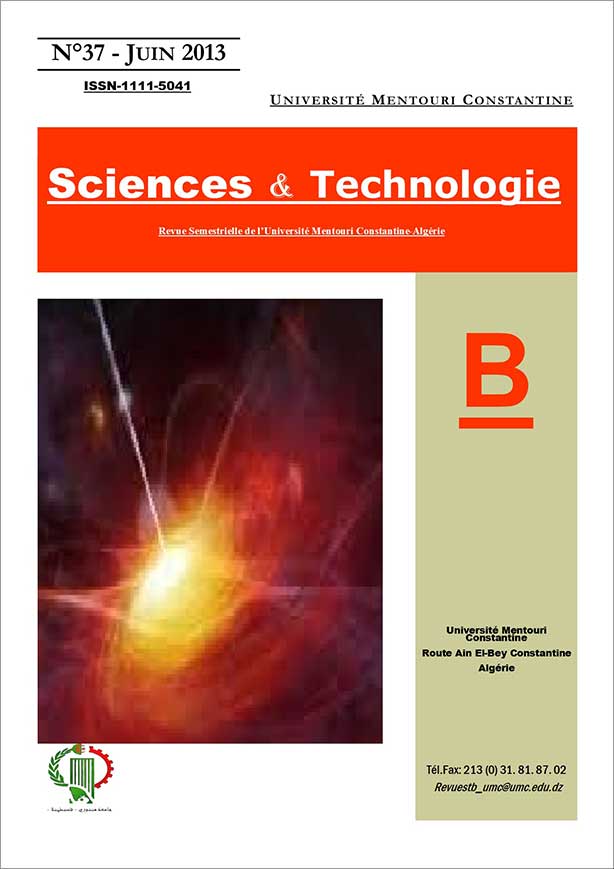INVESTIGATION INTO BRINELL HARDNESS TEST APPLIED TO ROCKS
Mots-clés :
Brinell Hardness, failure criteria, uniaxial compressive strength, Triaxial Tests, Angle of Friction, CohesionRésumé
The research work carried out shows the utility of brinell hardness for evaluating the rock strength . Tests were carried out on samples obtained from Hassi Messaoud OMN602 and OMN402 wells , at different depths ,rangings from 1900m to 2900m.
It is well known the brinell hardness in mechanical engineering, can be used on rocks in the same way as that of metals. Useful emperical relations between brinell hardness and the strength properties of the rock were obtained.
Références
. Tabor, D, (1954), Mohrs Hardness scale, A physical interpretation, proceeding physical society of London, sect .B , vol , 67, p 249.
,3]. Cone Indenter: new device for measuring rock strength mining and minerals engineering, march 1967, p18 N.C.B cone Indenter M.R.D.E Handbook N°5 (1977).
. Szlarrin, J. relationship between some physical properties of stone determined by laboratory tests, N.C.B, M.R.D.E report Np.19, March (1971).
. Coates, D.F(1964), classification of rocks mechanics, international journal of rock mechanics and mining sciences, Vol, 1, N°3, p 421.
. Van der vlis, A.C, rock classification by simple hardness test, proc. 2nd congress, ISRM(1970)p23-30 1-8.
. Brinell. J. A. 11eme congrès. Internationale. Méthode d’essai, Paris 1900 &
. Huitt, j .L & Mcglothlin B.B, the propping of fractures in formation susceptible to propping sand combedment. Drilland Prod. Practice, 1958, p 115.& relation of formation rock strength to propping agent strength in hydraulic fracturing. Soc. Petrol. Engr. Paper n° 1131 May 1965.
.Geertsma,jj (1985) :somme rock mechanical aspects of oil and gaz well completion SPEJ25 P848-856.
.Hawkes,I and Mellor, M (1970). uniaxial testing in rock mechanical laboratories engineering geology Vol 4 pp177-285.
. International society for rock mechanics commission on standardization of laboratory and field test (1978).
. ASTM. 1997. Laboratory determination of pulse velocities and ultrasonicelastic constants of rock. ASTM standard D2845-95. In Annual book of standards. American Society for Testing and Materials, West Conshohocken, Pa. Vol. 04.08, pp. 254–259.
. Hobbs, D.W. 1970. the behaviour of broken rock under triaxial compression, Intern. J. Rock Mech. Mining Sci.,vol.7, pp125-148 .
. 14.Hoek, E. and Brown, E.T. 1997. Practical estimates of rock mass strength. Intnl. J. Rock Mech. & Mining Sci. & Geomechanics Abstracts. 34 (8), 1165-1186.
International society for rock mechanics commission on standardization of laboratory and field test (1978).
International Society for Rock Mechanics (ISRM), Commission on Testing Methods (1978), Suggested methods for determining hardness and abrasiveness of rocks.
International Society for Rock Mechanics (ISRM), Commission on Testing Methods(2006), Suggested methods for determining the shore hardness value for rock.
International Society for Rock Mechanics (ISRM), Commission on Testing Methods(1977), Suggested methods for determining water content, porosity, density, absorption and related properties and swelling and slake-durability index properties.
International Society for Rock Mechanics (ISRM), Commission on Testing Methods (1979), Suggested methods for determining the uniaxial compressive strength and deformability of rock materials.
International Society for Rock Mechanics (ISRM), Commission on Testing Methods (1999), Suggested methods for complete stress-strain curve for intact rock in uniaxial compression.
International Society for Rock Mechanics (ISRM), Commission on Testing Methods (1978), Suggested methods for determining the strength of rock materials in triaxial compression.
] International Society for Rock Mechanics (ISRM), Commission on Testing Methods (1983), Suggested methods for determining the strength of rock materials in triaxial compression: revised version.
Téléchargements
Publié
Numéro
Rubrique
Licence
Les auteurs publiant dans cette revue acceptent les termes suivants :- Les auteurs détiennent le droit d'auteurs et accordent à la revue
le droit de première publication, avec l’ouvrage disponible simultanément [SPÉCIFIER LA PÉRIODE DE TEMPS] après publication, sous la licence Licence d’attribution Creative Commons qui permet à d'autres de partager l'ouvrage en en reconnaissant la paternité et la publication initiale dans cette revue. - Les auteurs peuvent conclure des ententes contractuelles additionnelles et séparées pour la diffusion non exclusive de la version imprimée de l'ouvrage par la revue (par ex., le dépôt institutionnel ou la publication dans un livre), accompagné d'une mention reconnaissant sa publication initiale dans cette revue.
- Les auteurs ont le droit et sont encouragés à publier leur ouvrage en ligne (par ex., dans un dépôt institutionnel ou sur le site Web d'une institution) avant et pendant le processus de soumission, car cela peut mener à des échanges fructueux ainsi qu'à un nombre plus important, plus rapidement, de références à l’ouvrage publié (Consulter The Effect of Open Access).

